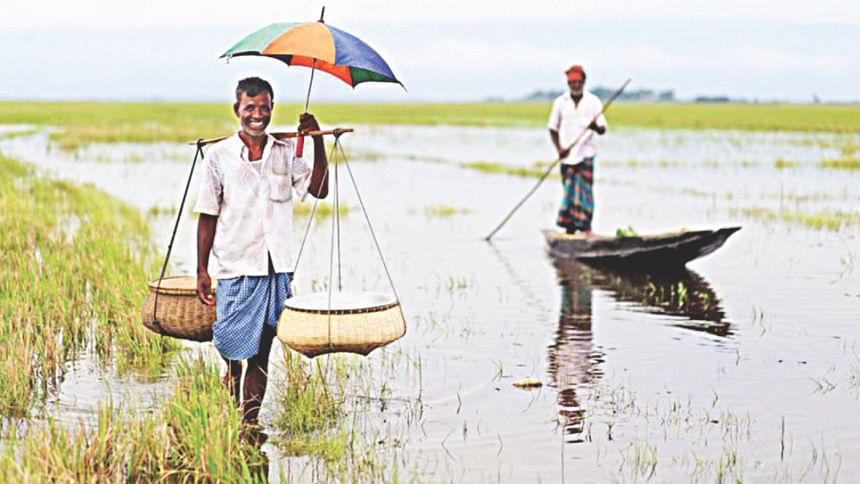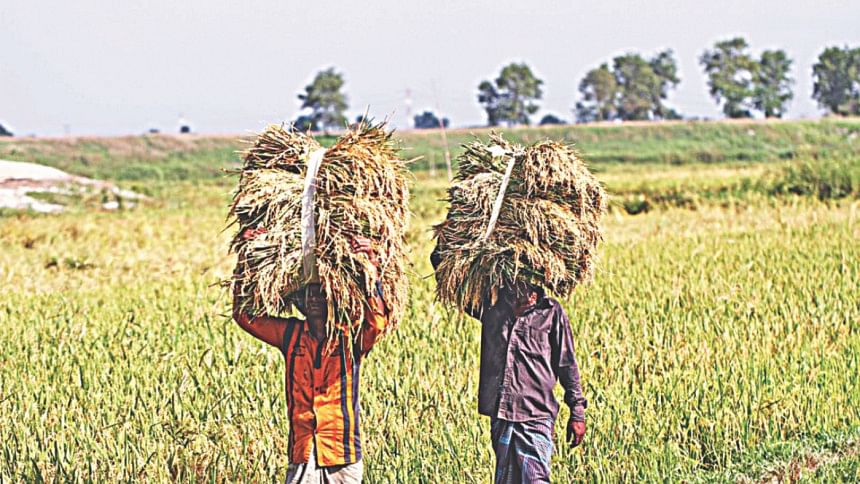Farming in the days of climate change

Climate change is a reality and so is the farming sector's resilience to it in Bangladesh.
With limited resources at hand and a rapidly increasing population to feed, some 18 million farming households in Bangladesh have shown fortitude against all odds. Farmers never called it quits in their constant fight against natural calamities, shrinkage of farmland, market irregularities, and all sorts of resource limitations.
With saline water from the gradually swelling sea moving further inland into prime arable lands and late monsoon upsetting the cropping seasons, agronomists called Bangladesh a virtual climate change laboratory.
Resilient farmers however would not give up. If pictures taken straight from the fields are something to go by, Bangladeshi farmers are taking all sorts of coping measures—locally developed or based on scientific inventions—to fight back global warming.
Agronomists fear that the rise in sea level would induce salinity to encroach further into the mainland as salinity-affected arable lands rose from 0.83 million hectares in 1990 to 1.2 million hectares in recent years.
In many parts of rice-growing Asia, farmers do not go for growing paddy in the dry winters, but here in Bangladesh high and ever-increasing demand for the staple pushed millions of growers over the last two decades to grow winter rice (boro) in addition to two other yearly rice seasons – rain-fed aus and aman.
But growing boro with a huge quantity of irrigation water is now taking its toll on a fast depleting groundwater table. Indiscriminate drawing of groundwater through irrigation pumps has no doubt helped Bangladesh triple its national rice basket in a span of four decades, but not without an environmental price.
Experts fear that over-exploitation of groundwater in the northern region is creating a vacuum, which is inviting saline sea water from the south to move inland, thereby posing potential threat to future agro-productivity in a vast tract of otherwise fertile arable lands.
Waning flow of fresh water from upstream is also inviting intrusion of salty seawater further inwards. Southern sea water up to 60 km north inland, has now managed to advance further up to 100 km northbound.
It's prudent from the government's part to no longer encourage water-intensive boro farming in the north, and to promote wheat, maize, vegetable and other winter crops as well as encouraging scientists to breed higher yielding aus and aman varieties instead.
Recipes for change are all too obvious for farmers in the northern region where farmers no longer afford to remain oblivious to climatic changes having serious ramifications on traditional ways of crop production.
Farmers say one of the most obvious fallouts of climate change is the gradual drifting of rain-fed rice season (aman) due to drought and delayed monsoon. In recent years, farmers in the rice-rich northern districts experienced the same problem of getting insufficient rain, missing out the appropriate time of planting aman seedlings, and then again, crop loss due to inundation from late monsoon bursts with too high rainfall in too short a period.
Changes in weather and erratic rain patterns not only pushed the Aman season from June-July to August-September but also, in a cascading effect, delayed planting and harvesting of winter rice boro. This made the country's top productive rice season vulnerable to sunstroke and susceptive to sterility.
Irrigated boro makes up 60% of the 34 million+ tons of annual rice output while the rest comes from rain-fed aus and aman.
Given the volatility of the international farm produce market, both in terms of output fluctuations and price instability, imports and aid dependence are not options that Bangladesh considers for ensuring its food security.
Policy planners rather opt for facing the challenges of climate change through various coping mechanisms and guarantee autarky in food.
Irrespective of the country's typical bipartisan political power formation, the farming sector is rather blessed in the sense that it got sustained policy supports from all post-autocracy governments (after 1990) other than some initial hiccups in the early 1990s. There were some troubles over farm-input management and marketing during the early 1990s, but since then the farming sector mostly got the policy directions it required.
To fight climate change-induced adversities in agriculture, Bangladesh did well in pursuing various adaptive mechanisms. What it badly requires though is more investment in farm research and development (R&D) so that the country can scale-up such adaptations.
Adaptation includes large-scale infrastructure projects such as building defences against rising sea levels; promoting agricultural best practices such as using less water, less pesticide, less chemical fertiliser; and inventing and planting crops that can weather extreme climatic situations.

It's brilliant that Bangladesh is a forerunner in having its own strategic action plan for climate change—the Bangladesh Climate Change Strategy and Action Plan—and also commissioning a specialised fund for climate adaptation—the Bangladesh Climate Change Trust Fund (BCCTF). The government has also spent a good amount of money from this fund over the last few years for initiatives such as developing salinity- and drought-tolerant paddy and wheat, building cyclone shelters, etc. In addition, Bangladesh has begun the process of mainstreaming the climate change issue in the overall development agenda, thus becoming one of the very first countries to do so.
However, governance still remains a huge concern as far as ensuring the quality of work and accountability of funds used for such activities are concerned. If better governance is ensured, such funds, whether generated at home or received from development partners, can be better mobilised for climate-smart agriculture (CSA). CSA is an integrative approach to address the inter-linked challenges of food security and climate change, which explicitly aims for three objectives: (1) sustainably increasing agricultural productivity to support equitable increases in farm incomes, food security and development; (2) adapting and building resilience of agricultural and food security systems to climate change at multiple levels; and (3) reducing greenhouse gas emissions from agriculture.
CSA considers these three objectives together at different scales (from farm to landscape), at different levels (from local to global), and over short and long time horizons, taking into account national and local specialties and priorities. CSA approaches entail greater investment in: (1) managing climate risks; (2) understanding and planning for adaptive transitions that may be needed, for example, into new farming systems or livelihoods; and (3) exploiting opportunities for reducing or removing greenhouse gas emissions where feasible.
Here in Bangladesh, farmers never shied away from accepting and adapting innovations or new practices in the farming sector. Equally, Bangladesh's home-grown agricultural geniuses have always been contributed generously as far as better crop breeds and farm technologies and practices are concerned.
Bangladeshi breeders, both at research stations and at university-level laboratories and greenhouses, have succeeded in developing various stress-tolerant varieties of crops. These have helped farmers to grow crops with equal or even enhanced yield potentials under stress conditions such as submergence, salinity, drought, heat, etc.
As there is every likelihood that the cereal production system will experience more drought, submergence, salinity and heat in coming days due to the consequences of climate change, focus is now on developing stress-tolerant varieties. And Bangladeshi agricultural scientists have, so far, done well in not only adapting new technologies but also in developing climate-smart crop varieties and technologies.
Crop production is adversely influenced by erratic rainfall, temperature extremes, increased salinity, drought, floods, river erosion, and tropical storms. All of which are likely to increase as a result of climate change. Increased extreme weather events and sea level rise would eventually put pressure on limited land resources for potential increased demand of farm products.
Thanks to fast developing infrastructure and industries, vast tracts of fertile farmlands are being used for other purposes too. This adds pressures on policy planners as well as the agricultural scientists to come up with solutions that would help grow more crops on less land.
In pursuit of increasing per unit farm productivity, over the past few years the government has been trying to apply all conventional and frontier sciences in agriculture. Bangladesh is the first country in South Asia to start cultivating food crops derived through genetic modification, thereby opening up new possibilities.
To save precious water resources, Bangladeshi farmers, at least in some areas, have also started to try the Alternate Wetting and Drying (AWD) technique, a new irrigation method. Though very few stages of rice growth require standing water, farmers traditionally keep irrigating rice-fields till the lands are fully submerged. As a results, irrigation waters are misused and farmers bear higher costs for unnecessary watering.
The simple technology of AWD requires just a perforated plastic pipe that measures the depth at which the soil is saturated so farmers do not irrigate in excess. This helps save up to 30% of water otherwise wasted and farmers' irrigation costs.
As land gets scarce at many places, ingenious farmers grow their seedbeds and plants on floating gardens. Hydroponics system in Bangladesh, based on floating gardens, has gotten recognition in December 2014 by the United Nations' Food and Agricultural Organisation (FAO) as a Globally Important Agricultural Heritage System (GIAHS) for innovation, sustainability, and adaptability.
Farmers in some parts of the country where flood waters can remain for a prolonged period of time have developed floating gardens in which plants can be grown on the water on floating organic beds of water hyacinth, algae and other plant residues. This environmentally friendly traditional cultivation technique utilises the natural resources of wetlands to grow vegetables and other crops almost all year round, providing numerous social, economic, agricultural, and ecological benefits to the local population.
Through various adaptive and coping mechanisms farmers in Bangladesh are staying productive in the farms and facing the challenges of climate change effectively.
The writer is Assignment Editor, The Daily Star.

 For all latest news, follow The Daily Star's Google News channel.
For all latest news, follow The Daily Star's Google News channel. 



Comments